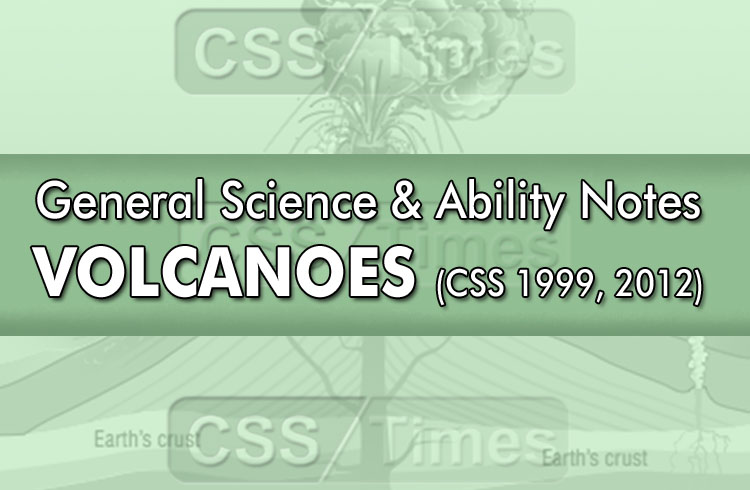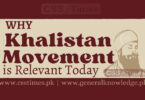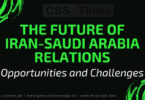Volcanoes (CSS 1999, 2012)
CSS General Science & Ability Notes
A volcano is a place on the Earth’s surface (or any other planet’s or moon’s surface) where molten rock, gases and pyroclastic debris erupt through the earth’s crust. Volcanoes vary quite a bit in their structure – some are cracks in the earth’s crust where lava erupts, and some are domes, shields, or mountain-like structures with a crater at the summit.
Magma is molten rock within the Earth’s crust. When magma erupts through the earth’s surface it is called lava. Lava can be thick and slow-moving or thin and fast-moving. Rock also comes from volcanoes in other forms, including ash (finely powdered rock that looks like dark smoke coming from the volcano), cinders (bits of fragmented lava), and pumice (light-weight rock that is full of air bubbles and is formed in explosive volcanic eruptions – this type of rock can float on water).
The Word Volcano:
The word volcano comes from the Roman god of fire, Vulcan. Vulcan was said to have had a forge (a place to melt and shape iron) on Vulcano, an active volcano on the Lipari Islands in Italy.
Why do volcanoes erupt?
Let us start with what the earth is made of:
- The earth is made up of three layer parts. The outer crust is the layer on which we live. It is estimated to be about 1800 miles deep. Then there is the mantle; and then the core (inner and outer core)
- The mantle is made up of molten material and gases. Molten materials are solids (like rock) that have turned into liquid because of extreme heat. The name for molten rock and other gases in the earth’s mantle is Magma. Magma is liquid made up of many crystals, fragments and gases including oxygen, silicon, iron, aluminum, magnesium and manganese. When they cool off on the earth’s surface, they turn into magmatic or igneous rocks.
- Whenever extreme pressure builds in the mantle, along fault lines (openings or cracks in weak spots in the earth’s crust) an eruption is likely to happen next. During an eruption, molten materials (soon to become lava) gush out through spaces in the crust to the surface.
NOTE: Molten rock is called magma when it is inside the crust but once it gets to the surface of the earth it is called lava. - Eruptions can be in the form of lava fragments shooting into the atmosphere and forming thick clouds of lava. Some also flow slowly (non-violent) from the vent, flooding the area around it. Very fine particles of ash may also be discharged high into the stratosphere and further carried away by wind action.
- Fresh lava is believed to be about 2,200°F. It can be red hot as it shoots from the vent and turn into gray or black as it cools. Lava rich in silicon is like honey, and flows a lot more slowly from the vent. In other types, lava also comes in thick, pasty form.
Types of Volcano
There are three main types of volcano. Scientists decide what type a volcano is examining the plate movements that have caused it to form.
- ubduction volcanoes. Subduction volcanoes occur where plates move towards each other and collide. The areas where this happens are called destructive plate margins, because the earth’s crust is being destroyed. The diagrams on this page show that three main types of destructive plate margin, where subduction volcanoes are formed.
- Rift volcanoes. Where plates are moving apart, as in the middle of the Atlantic Ocean, magma rises through the gap between the separating plates and creates new rock. Here the volcanoes are known as rift volcanoes. There are more rift volcanoes than subduction volcanoes, but we hear far less about them. Most of them are hidden from view on the ocean floor, and they do not often threaten human life or property. Also, they usually erupt more gently than other types of volcano, with lava that oozes rather than explodes from inside them. Iceland, which straddles the Mid-Atlantic Ocean Ridge, and the Rift Valley of East Africa are two of the few places where rift volcanoes are found on land.
- Hot-spot volcanoes. Some volcanoes are found away from the edges of the plates. They are formed where rising plumes of magma force their way to the surface from deep within the mantle, a ‘hot spot’. As the plate moves, the existing volcano is carried away from the hot spot and becomes extinct. The next time the pressure builds up, new magma erupts to form another volcano in its place. The best-known hot-spot volcanoes are in the Hawaiian Islands. The oldest in the west, such as Niihau and Kauai, contain extinct volcanoes, but the eastern islands of Maui and Hawaii itself still have active volcanoes.
Distribution of Volcanoes
There are three volcanic belts, besides many volcanoes which are outside these belts. The three volcanic belts are as under:
- The Circum-Pacific belt
- The Mid-Continental belt
- The Mid-Atlantic belt.
The Circum-Pacific belt:
This is the most important belt of volcanoes. This is the so called Ring of Fire. The Ring of Fire is an area where a large number of earthquakes and volcanic eruptions occur in the basin of the Pacific The Ring of Fire has 452 volcanoes and is home to over 75% of the world’s active and dormant volcanoes It is sometimes called the circum-Pacific belt or the circum-Pacific seismic belt.About 90% of the world’s earthquakes and 81% of the world’s largest earthquakes occur along the Ring of Fire. The belt extends through the Andes of South America, Central America, Mexico, the Cascade Mountains of Western United States, the Aleutain Islands, Kamchatka, the Kuril Isles, Japan, the Philippines, Celebes, New Guinea, the Solomon Islands, New Caledonia and New Zealand.
The Mid-Continental belt:
This belt has various volcanoes of the Alpine mountain chain, Mediterranean Sea (Stromboli, Vesuvius, Etna etc.), Volcanoes of the Aegean Sea. Mt. Ararat, Elburz and Hindu Kush are also included in this belt. In the region where the boundaries of Iran, Afghanistan, and Pakistan meet, there are several volcanic cones of large size, and one or two of them emit steam and other gases. This region has also a few extinct volcanoes.
The Mid- Atlantic belt:
As the name indicates, this belt includes the volcanoes of the Mid-Atlantic Ridge. The volcanoes associated with the Atlantic Ocean are located either on swells or ridges rising from the sea floor, or on or near the edge of the continent where it slopes abruptly into the deep oceanic basins. However, in each case, the volcanoes are associated with zones of crystal movement.
The effects of volcanic eruptions
Unlike other natural disasters such as floods, wild fires and earthquakes, volcanoes can have some positive effects, even though they can be very disastrous.
Let us see some negative effects of volcanoes:
- Eruptions occurring close to human settlements may spill and destroy lives and property. People often have to be evacuated. Example: Chaparrastique volcano in El Salvador started erupting on 29 Dec, 2013. Anyone living within 2 miles of the volcano is evacuated.
- Ash discharged very high into the stratosphere can have negative consequences on the ozone layer.
- Landscapes and natural sceneries can be destroyed.
- Ash and mud can mix with rain and melting snow, forming lahars. Lahars are mudflows flowing at very fast pace.
Some positive effects of volcanoes include: - Different types of erupting volcanoes provide extraordinary scenery, so beautiful and natural that they attract tourists to the area, bringing in some economic value.
- Places close to volcanic activities tend to have higher potential for geothermal energy, which can be an advantage to the towns and cities.
- Some ash and lava breakdown become soils that are rich in nutrients, and become good areas for crop planting activities.
Check Other NOTES for General Science & Ability
- What is An Avalanche? | General Science & Ability CSS Notes
- Waves – Tides & Current | CSS General Science Notes
- What is Tsunami? Their Generated & Characteristics | CSS General Science & Ability Notes
- Volcanoes | CSS General Science & Ability Notes
- What is Earthquake? | General Science & Ability Notes
- The Solar System | General Science & Ability Notes for CSS







